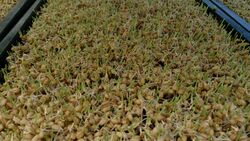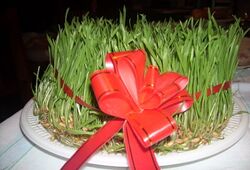Biology:Wheat sprout
Wheat sprout (Persian: جوانه گندم) is a product of germinating wheat seeds in a wet and relatively warm environment in a process called sprouting. It is commonly known and used in Iranian plateau. However, it is sometimes used instead of barley in the form of malt (early stage sprout) for making beer.
It is used in numerous Persian pastries, dishes, and desserts. Also, it has been used traditionally in the new year's Haft-Seen table decoration in the form of Sabzeh (wheat grass) and a delicious dessert called Samanu as the symbols of blessing from Ahura-Mazda.[1] This custom has been observed by most of the people on Iranian Plateau and some of the populations in beyond (e.g. some parts of India, Yemen, Lebanon, Russia, and China) for thousands of years maybe as old as emerging of Zoroaster.
One of the confections called Sohan is made up of mainly wheat sprout flour. It is a traditional Persian saffron brittle toffee and made in the holy city of Qom.
A fine powder of the dried sprout is widely used in Iran and a few other countries as a skin care product (e.g. facial masks) which is not yet approved by the scholar resources.
Samani
In Azerbaijan, the growing of samani (Azerbaijani: səməni) - green sprouting wheat - is the most sacred Novruz ceremony as the herald of spring.[2][3][4] Sprouting samani symbolises sowing and a rich harvest, it represents grain, bread, increase and abundance. Grain and abundance is a pledge of life, existence, the most vital material necessity for life.[5] People have always grown samani from wheat, barley, peas, lentils or other grains in copper dishes; they have always revered it and rejoiced at its sprouting.
References
- ↑ Research, Health (1996-09-01) (in en). What the Great Religions Teach. Health Research Books. ISBN 9780787313104. https://books.google.ca/books?id=s5Q10Dpw30MC&pg=PA3&dq=wheat+Ahura-Mazda&hl=en&sa=X&ved=0ahUKEwi78_qZgoDTAhVDwWMKHRyMDgU4ChDoAQhOMAk#v=onepage&q=wheat%20Ahura-Mazda&f=false.
- ↑ Türk Mitolojisi Ansiklopedik Sözlük, Celal Beydili, Yurt Yayınevi (Sayfa - 492)
- ↑ «Səməni nəğməsi» (Russian: «Песня сэмэни»), стихотворение. Автор - поэт, публицист Абульфат Мадатоглу. Баку, 1988, изд.«Гянджлик», 61 стр.
- ↑ PEDAQOJİ VƏ BƏDİİ DÜŞÜNCƏNİN VƏHDƏTİNDƏ YARANAN ƏSƏRLƏR «Сэмэни», стихотворение. Автор - поэт, доктор педагогических наук, профессор, действительный член Российской Академии педагогических и социальных наук Аждар Агаев.
- ↑ Türk Mitoloji Sözlüğü, Pınar Karaca - "Semeni" (in Turkish)
External links for Samani
- Səməni hansı dərdlərin dərmanıdır? (in Azerbaijani)
- BƏRDƏ RAYONUNDA 6 METR HÜNDÜRLÜYÜNDƏ SƏMƏNİ YETİŞDİRİLİB (in Azerbaijani)
- Səməni, saxla məni... (in Azerbaijani)



